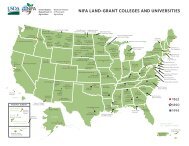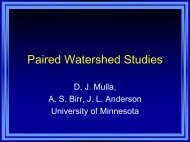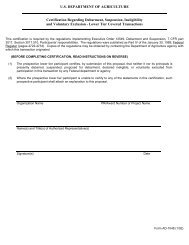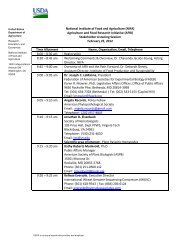Possession, Use, and Transfer of Biological Agents and Toxins
Possession, Use, and Transfer of Biological Agents and Toxins
Possession, Use, and Transfer of Biological Agents and Toxins
- No tags were found...
Create successful ePaper yourself
Turn your PDF publications into a flip-book with our unique Google optimized e-Paper software.
Agricultural Bioterrorism Protection Act<strong>of</strong> 2002; <strong>Possession</strong>, <strong>Use</strong>, <strong>and</strong> <strong>Transfer</strong> <strong>of</strong><strong>Biological</strong> <strong>Agents</strong> <strong>and</strong> <strong>Toxins</strong> (7 CFR 331; 9 CFR121)Lee Ann Thomas, D.V.M., M. SDirector, Select Agent, Organisms <strong>and</strong> Vectors, <strong>and</strong> AnimalsNational Center for Import <strong>and</strong> ExportLaboratory Security WorkshopSeptember 7, 2007
Public Health Security <strong>and</strong> BioterrorismPreparedness Response Act <strong>of</strong> 2002• Signed into law June 12,2002• Subtitle B cited as the“AgriculturalBioterrorism ProtectionAct <strong>of</strong> 2002”• Requirements:• List <strong>of</strong> select agents <strong>and</strong>toxins• Notification <strong>of</strong> <strong>Possession</strong>• Registration for <strong>Possession</strong>,<strong>Use</strong>, <strong>and</strong> <strong>Transfer</strong>• Exemptions
USA Patriot Act(Uniting <strong>and</strong> Strengthening America by ProvidingAppropriate Tools Required to Intercept <strong>and</strong> ObstructTerrorismAct <strong>of</strong> 2001)• Public Law 107-56 Signed: 10/23/2001• Sec. 175b. <strong>Possession</strong> by Restricted Persons– No restricted person shall ship, possess, or receive aselect agent.
Types <strong>of</strong> Select <strong>Agents</strong> <strong>and</strong> <strong>Toxins</strong>• HHS-only <strong>Agents</strong> (HHS has sole authority <strong>and</strong>responsibility to regulate)− Select agents <strong>and</strong> toxins that may affect public health<strong>and</strong> safety• USDA-only <strong>Agents</strong> (USDA has sole authority <strong>and</strong>responsibility to regulate)− Select agents <strong>and</strong> toxins that may affect animal <strong>and</strong>plant health <strong>and</strong> animal <strong>and</strong> plant products•“Overlap <strong>Agents</strong>”− Select agents <strong>and</strong> toxins subject to regulation by bothagenciesThe Act provides for interagency coordination between thetwo departments regarding overlap select agents <strong>and</strong> toxins
List <strong>of</strong> <strong>Biological</strong> <strong>Agents</strong> <strong>and</strong> <strong>Toxins</strong> (VS)Criteria:• Effect <strong>of</strong> exposure to the agent or toxin on animalhealth, <strong>and</strong> on the production <strong>and</strong> marketability <strong>of</strong>animal products• Pathogenicity <strong>of</strong> the agent or the toxicity <strong>of</strong> thetoxin• Methods <strong>of</strong> transmission• Availability/effectiveness <strong>of</strong> pharmacotherapies<strong>and</strong> prophylaxis• Economic impact• Inclusion on OIE A <strong>and</strong> B or Australian Grouplists
List <strong>of</strong> <strong>Biological</strong> <strong>Agents</strong> <strong>and</strong> <strong>Toxins</strong> (VS)African horse sickness virusAfrican swine fever virusAkabane virusAvian influenza virus (highly pathogenic)Bluetongue virus (exotic)Bovine spongiform encephalopathy agentCamel pox virusClassical swine fever virusCowdria ruminantium (Heartwater)Foot-<strong>and</strong><strong>and</strong>-mouth disease virusGoat pox virusJapanese encephalitis virusLumpy skin disease virusMalignant catarrhal fever virus(AlcelaphineHerpes virus)Menangle virusMycoplasma capricolum /M. F38/M.mycoides capri (contagious caprinepleuropneumonia)Mycoplasma mycoides mycoides(contagious bovine pleuropneumonia)Newcastle disease virus (velogenic(velogenic)Peste des petits ruminants virusRinderpest virusSheep pox virusSwine vesicular disease virusVesicular stomatitis virus (exotic)
List <strong>of</strong> <strong>Biological</strong> <strong>Agents</strong> <strong>and</strong> <strong>Toxins</strong>(Overlap USDA/HHS)Bacillus anthracisCoccidioides immitisBotulinum neurotoxinsCoxiella burnetiiBotulinum neurotoxin producingEastern equine encephalitis virusspecies <strong>of</strong> ClostridiumFrancisella tularensisBrucella abortusHendra virusBrucella melitensisNipah virusBrucella suisRift Valley fever virusBurkholderia malleiShigatoxinBurkholderia pseudomalleiStaphylococcal enterotoxinsClostridium perfringens epsilonT-2 2 toxintoxinVenezuelan equine encephalitisvirus
Exemptions from Registration• Clinical or diagnostic laboratories (agents or toxinscontained in diagnostic specimens or for verification):− Identification immediately reported− Within 7 days <strong>of</strong> identification agents or toxinstransferred or inactivated• Clinical <strong>and</strong> diagnostic laboratories (agents or toxinscontained in pr<strong>of</strong>iciency test samples):− Identification immediately reported− Within 90 days <strong>of</strong> receipt, agents/toxinstransferred or inactivated
Exemptions from Registration• <strong>Possession</strong>, use, or transfer <strong>of</strong> products that are, bear,contain select agents or toxins licensed under:− Federal Food, Drug, <strong>and</strong> Cosmetic Act− The Virus Serum Toxin Act− The Federal Insecticide, Fungicide, <strong>and</strong> Rodenticide Act− Public Health Service Act pertaining to biological products(42 U.S.C. 262)− Investigational products authorized any Federal laws above• Administrator determines no additional regulation isrequired• Requires exemption request
Exemptions from Registration• <strong>Toxins</strong> (aggregate per principal investigator):− 0.5 mg <strong>of</strong> Botulinum neurotoxin− 5 mg <strong>of</strong> Staphylococcal enterotoxin− 100 mg <strong>of</strong> Clostridium perfringens epsilon toxin− 100 mg <strong>of</strong> Shigatoxin− 1,000 mg <strong>of</strong> T-2 T 2 toxin• Exclusions for attenuated agents− B. abortus RB5, Strain 19− http://www.aphis.usda.gov/vs/ncie/bta.html(Notification <strong>of</strong> exclusion <strong>of</strong> attenuated strains)
Registration for <strong>Possession</strong>, <strong>Use</strong>, <strong>and</strong><strong>Transfer</strong>• Entities that possess, use, or transfer* VS or PPQonly select agents must register with USDA/APHIS.• Entities that possess, use, or transfer* overlap agentsor toxins must register with either USDA/APHIS orHHS/CDC, but not both.• Registrations will be valid for a maximum <strong>of</strong> 3 years<strong>and</strong> may be renewed.• Registration package <strong>and</strong> other forms are the same forboth agencies
<strong>Possession</strong>, <strong>Use</strong>, <strong>and</strong> <strong>Transfer</strong> <strong>of</strong> SelectAgent or ToxinRegistration:1. Application (APHIS/CDC Form 1)Responsible Official <strong>and</strong> Alternate ResponsibleOfficialList <strong>of</strong> <strong>Agents</strong>/<strong>Toxins</strong>Biosafety <strong>and</strong> Laboratory InformationPersonnel to be authorized accessSpecific laboratory information2. Security Risk Assessment (SRA) individuals, entity, <strong>and</strong>corporate <strong>of</strong>ficers3. Security <strong>and</strong> Biosafety Plans4. Laboratory Inspection
SECURITY RISK ASSESSMENT(SRA)• All individuals needing access to select agents or toxins <strong>and</strong>owners <strong>of</strong> entities seeking to register must have a securityrisk assessment (database <strong>and</strong> fingerprint check) conductedby the Attorney General.• The Attorney General has designated the Federal Bureau <strong>of</strong>Investigation (FBI), Criminal Justice Information ServicesDivision (CJIS), to conduct the security risk assessments.• CJIS sends results to lead agency (CDC or APHIS)
SECURITY RISK ASSESSMENT(SRA) – Restricted Individuals• Under indictment for a crime punishable by imprisonmentfor a term exceeding 1 year• Convicted <strong>of</strong> any crime punishable by imprisonment for aterm exceeding 1 year• A fugitive from justice• Unlawful user <strong>of</strong> any controlled substance• Alien illegally or unlawfully in the US• Adjudicated as a mental defective or committed to a mentalinstitution• Alien who is a national <strong>of</strong> a country to which the Secretary<strong>of</strong> State has determined that that country has repeatedlyprovided support for acts <strong>of</strong> international terrorism• Discharged under dishonorable conditions
Security PlansSufficient to safeguard against unauthorized access, theft, loss orrelease. Must be based on a site-specific specific risk assessment <strong>and</strong>provide graded protection in accordance with the risk.• Describe procedures for physical security, inventory control, <strong>and</strong>information systems control• Provisions for controlling access• Provision for routine cleaning <strong>and</strong> maintenance• Procedures for removing unauthorized individuals• Procedures for addressing loss or compromise <strong>of</strong> keys, passwords,etc• Procedures for reporting unauthorized or suspicious persons oractivities; theft, loss <strong>and</strong> release; or alteration <strong>of</strong> inventory records• Provisions for ensuring all personnel with SRA approvalunderst<strong>and</strong> <strong>and</strong> comply with the security procedures in place
SecurityThe entity must adhere to the following or implement measures to achieve anequivalent or greater level <strong>of</strong> security:• Allow access to only to individuals with an SRA-approval• Allow individuals without SRA-approval to conduct routine cleaning, maintenance, orrepairs only when continuously escorted by an approved individual• Provide for control <strong>of</strong> agents by requiring freezers, refrigerators, rs, cabinets, or other areaswhere agents are stored to be secured against access• Inspect all suspicious packages before they are brought into or removed from an areawhere agents are stored or used• Establish a procedure for intra-entity transfer, including chain <strong>of</strong> custody• Require that SRA-approved individuals refrain from sharing unique means <strong>of</strong> accessingagents (ie(passwords, keys….)• Require immediate reporting <strong>of</strong>: 1) loss <strong>of</strong> keys, passwords; 2) Suspicious Spersons orpackages; 3) theft or loss <strong>of</strong> agent; 4) Evidence <strong>of</strong> alteration <strong>of</strong> inventory/use records• Separate areas where agents are used/stored are separate from public areas <strong>of</strong> thebuilding
http://www.selectagents.gov/securitydoc.htm
Laboratory Inspection• Coordination efforts between CDC <strong>and</strong> USDA (one(inspection)• Inspection covers:• Biosafety (laboratory <strong>and</strong> animal)• Security• Records• Training• Incident Response
Number <strong>of</strong> Entities Registering a SelectAgent or Toxin with HHS/CDC orUSDA/APHIS(n = 409 registered entities; 7/25/07)HHS/CDC: 82% (n= 328)USDA/APHIS: 18% (n=81)
• Notification:Additional requirements1. <strong>Transfer</strong> (APHIS/CDC Form 2)2. Theft, Loss, Release (APHIS/CDC Form 3)3. Identification (APHIS/CDC Form 4)4. Request for Exemption <strong>of</strong> Select <strong>Biological</strong> <strong>Agents</strong><strong>and</strong> <strong>Toxins</strong> – Investigational products, public healthor agricultural emergency (APHIS/CDC Form 5)• Web Sites:http://www.aphis.usda.gov/programs/ag_selectagent/index.shtml• http://www.selectagents.govwww.selectagents.gov/
The Sunshine ProjectNews Release12 April 2007Texas A&M University Violates Federal Law in Biodefense LabInfection- Student climbs into dirty bioaerosol chamber <strong>and</strong> contracts brucellosis- A&M failed to report the incident to federal authorities-May lose federal funding <strong>and</strong> owe $750,000 or more in fines.Inquiry leaves Boston tularemia mystery unsolvedApril 14, 2005 (CIDRAP News) – Despite 4 months <strong>of</strong> investigation,the source <strong>of</strong> bacteria that caused tularemia in three laboratoryworkers at Boston University remains a mystery, the Boston PublicHealth Commission (BPHC) has reported.
Questions?


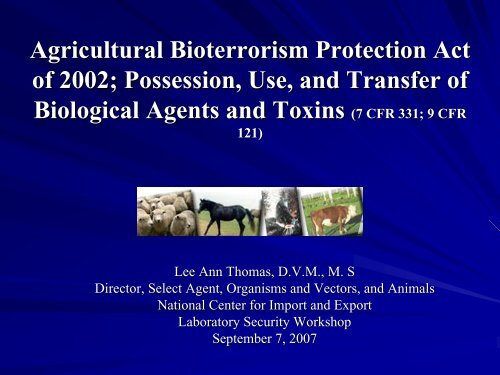
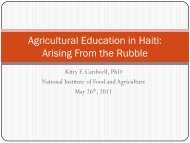

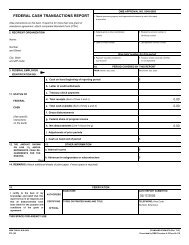
![[PDF] Choose Carbohydrates Wisely](https://img.yumpu.com/36196894/1/190x245/pdf-choose-carbohydrates-wisely.jpg?quality=85)
